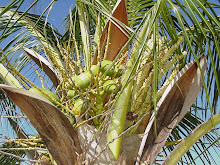Before The Colonel and I left Indiana after my mother's June funeral we made a visit to Ft. Wayne. I had never been to Ft. Wayne and was looking forward to some of it's historical sites.
The Colonel knew that John Chapman aka "Johnny Appleseed" was buried somewhere in Ft. Wayne. We have all heard about Johnny Appleseed (thanks to Walt Disney) but what do we really know about him?
John Chapman or Johnny Appleseed (1774-1845) was a legendary planter of orchards in Ohio, Indiana and Illinois. First hand accounts said there were 15,000 trees growing in his largest nursery along the Maumee River just twelve miles from Ft. Wayne.
He was a real person, was a friend to all of God's creatures and a missionary for the Swedenborgian religion, a Christian denomination.
Johnny Appleseed was a smart business man. Moving ahead of the waves of westward bound settlers, he purchased property, carefully sowed apple seeds, and had seedlings when settlers arrived. His seedlings were very valuable because apples were a symbol of permanency. He sold trees for 3 cents if you planted them and 6.5 cents if he planted them for you. Johnny was also very generous often saying, "Pay me when you can."
Material things meant little to Johnny except when they could make a child smile, give a pioneer family the means to improve their diet or increase their cash income from apples, cider or Applejack. Cider and Applejack were used as currency in Colonial America.
Johnny Appleseed lived a life of service in harmony with nature that impressed Native Americans as well as fellow Americans. He was a proud patriot. His thoughts were of God and the afterlife and his greeting was often, "I have good news from Heaven!" Johnny was a good salesman and people loved him.
After a little driving around and asking for the location of Johnny Appleseed's grave site The Colonel and I finally found it.
Johnny Appleseed is buried atop a hill and on that hill are planted apple trees (the same type of apples that Johnny planted).
The Colonel and I were thrilled to have been able to visit Johnny Appleseed's grave site. The visit made us curious about Applejack (mentioned on the informational board at the base of the hill). We had not heard of it before and had to learn more and possibly taste the alcoholic beverage that played such a large part in Colonial America's economic history.
Well, The Colonel did some research and found that Applejack is still made. He also discovered that we could purchase some in Fort Myers.
In his research, The Colonel found out that Laird's Applejack was the one to try. We drove south to purchase a bottle.
A little history lesson on Laird's Applejack (on the bottle). It was first made by William Laird in Monmouth, New Jersey in 1698. Around 1760, George Washington discovered this unique beverage, asked for and received the Laird Family recipe and soon introduced Applejack to the Virginia Colony.
Well, of course after reading the history of Laird's Applejack The Colonel and I were that much more interested in tasting it...I mean George Washington drank the stuff!
Just opening the bottle and getting a whiff of the Applejack prompted us to break out the smallest of glasses...this stuff was going to be strong.
The initial taste was of strong alcohol and the amber liquid mildly burned the mouth and throat as it went down. There was then a delicious, delicate apple aftertaste.
I liked trying this Colonial American beverage. It is not one that I will drink frequently so the bottle will last for a long while. Who knows, maybe if there is a Zombie Apocalypse I will have to revert to the colonial days and use the remainder as currency.












































nice story
ReplyDeleteVery interesting. Jenn
ReplyDelete